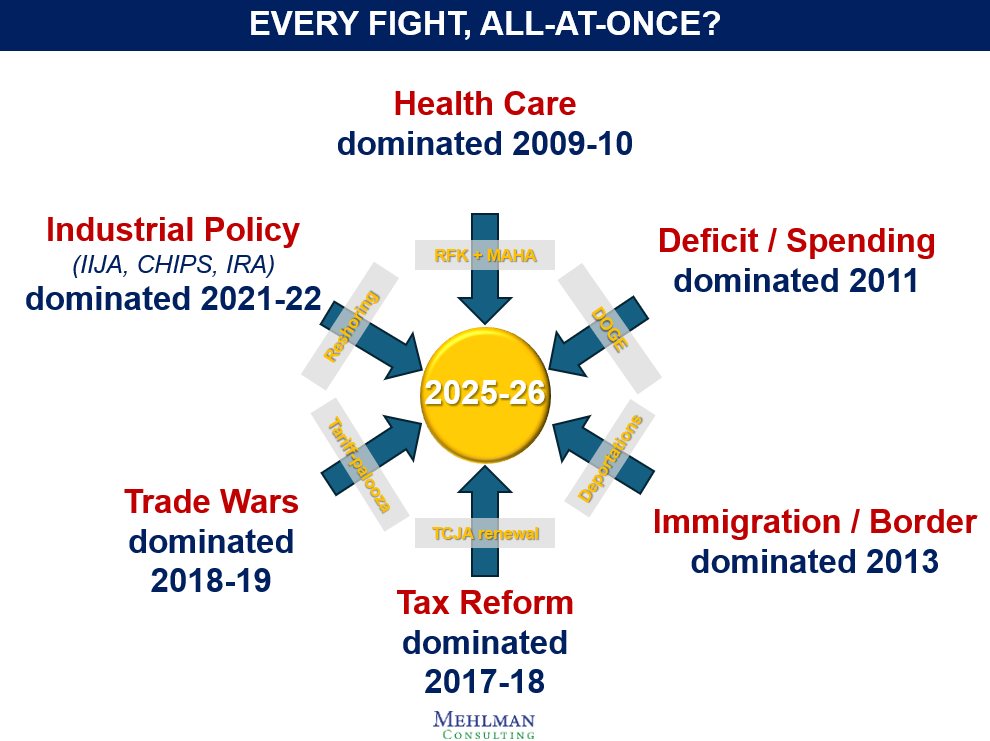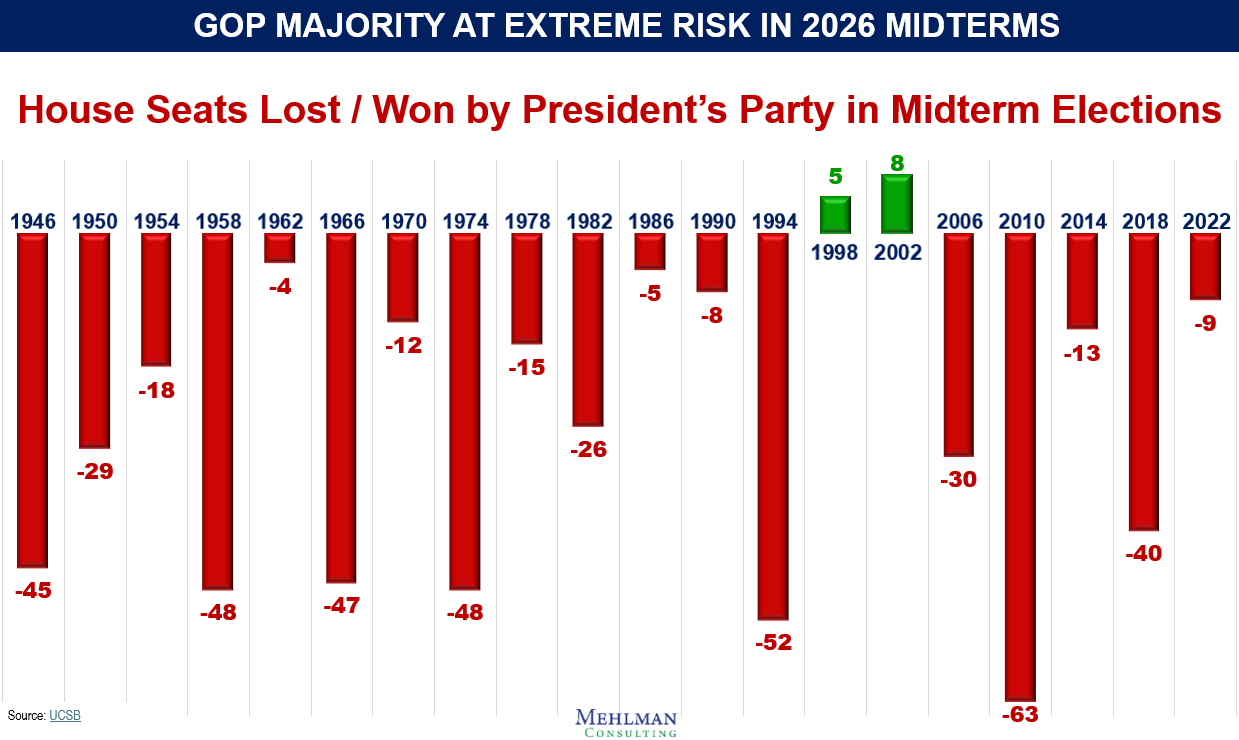Six-Chart Sunday (#57) – Every Fight, Everywhere, All-at-Once
6 Infographics + 1 Audio (Bari Weiss' interview of Martin Gurri)
There are months when nothing happens in Washington. And then there are months when decades happen. In the past 32 days, the new Trump Administration has moved faster, further and more aggressively to transform government than any President since FDR. We’ve previously looked at actions across a host of critical areas – trade, budget, DOGE. And we assessed the odds of activism returning. Today we consider what might slow Trump 2.0 down: bandwidth, markets, courts, House margins & midterms.
Executive Ordering. The second Trump Administration launched with an unprecedented volume of executive orders & actions starting day one, a shock-and-awe, flood-the-zone strategy based on lessons learned from 2017-2020 and four subsequent years of planning. Trump 2.0’s 70 EO’s in just 30 days exceeds those in the first 100 days of every President since 1933. Tom Joyce of MUFG securities finds 21% of Trump new EO’s deal with operations of the federal government, 15% with DEI, 14% foreign affairs, 10% border/immigration, 8% trade/tariffs, 8% healthcare, 8% climate/energy, 5% defense, 4% science / tech and 7% “other.” (Data shows OpenAI Deep Research report on EO’s in first 100 days based on Federal Register data).
Does Washington Have the Bandwidth? Working in a town of “northern charm & southern efficiency,” Washington generally has the bandwidth for one giant policy battle at a time. In 2009-10, it was the Affordable Care Act. 2011 was consumed by Simpson-Bowles, the “Supercommittee” and national debt. In 2013 it was the Senate Gang of 8 advancing bipartisan immigration reform; 2017 Trump’s tax cuts. 2018-19 were all about Trump’s trade wars and the end of the Washington Consensus, 2020 was COVID, of course, and 2021-22 was dominated by Biden’s ambitious industrial policy agenda (Infrastructure, IRA, CHIPs). Trump 2.0 aims to advance on all of these fronts simultaneously – tackling debt/spending, re-shaping government, massive tax cuts, widespread new tariffs, mass deportations and broad health reforms (MAHA) concurrently.
Will Trade Wars, Mass Deportation or DOGE Disruptions Hurt Markets / Raise consumer prices? President Trump famously sees financial markets as a proxy for the effectiveness of his economic policies. Yet markets are concerned by the prospects of trade wars or mass deportations potentially raising consumer prices / accelerating inflation, squeezing corporate profits and/or potentially triggering a recession. Tariff-exposed stocks have lagged the broader market since the Inauguration as a result.
Will Court Rulings Curtail Assertions of Broad Executive Power? Modern presidencies are increasingly stymied by judicial rulings… President Bush’s war on terror, President Obama’s clean power plan, President Trump’s rescission of DACA, President Biden’s $500B student debt relief plan were all stymied by the Supreme Court. Trump 2.0 is no different: “the legal clashes over President Trump’s blizzard of executive actions are intensifying, with new lawsuits and fresh rulings emerging day and night. As of Feb. 21, at least 29 of those rulings have at least temporarily paused some of the president’s initiatives.” A growing number of these legal challenges are brought by attorney generals from multiple states, per data from Marquette University’s Prof. Paul Nolette.
Are the GOP’s House Margins Too Narrow to Pass Trump’s Priorities. A number of Trump 2.0 priorities will require legislative action, especially if Courts reject executive unilateralism. Republicans have the smallest House majority since 1931. They will need Democratic votes to avert a shutdown, increase the debt ceiling and advance multiple other priorities both in the Senate and likely the House. Can Trump 2.0 realistically expect 100% GOP loyalty?
Will the 2026 Midterm Elections End the GOP Trifecta? Four of the last five Presidents saw their parties lose control of the House in their first midterms, significantly slowing Administration progress. The party holding the White House lost seats in 18 of the 20 midterms since World War II, with the average loss 25 seats (chart). Such a big loss is highly unlikely in 2026, with the GOP only defending 3 seats won by Harris in 2024, while Democrats defend 13 Trump-won seats. Further the playing field is smaller than in past years: just 39 of 435 seats are rated toss-up or lean (22 Dem-defended, 17 GOP). But Democrats only need to net +3 to regain the House, and history suggests that’s eminently doable for the party out of power.
AUDIO
Two of the people I most hope to interview are Free Press founder Bari Weiss and author Martin Gurri, who wrote Revolt of the Public (amazing book). In 2021 Weiss interviewed the former CIA analyst who had predicted Trump, Brexit, WallStreetBets, BLM and the Yellow vests, among other disruptions. Gurri believes all of these movements are connected by a single force: the Internet. Just as the printing press transformed humanity in the 1400s, Gurri argues that we are now living through a another, more radical transformation that’s just getting started. Great listen!










As usual, great graphics. As you point out, Washington has a limited attention span, usually focusing on one thing at a time. Trump flooding the zone seems to be an intentional way to use that to his advantage.
Bruce's charts are the absolute best too to understand politics.